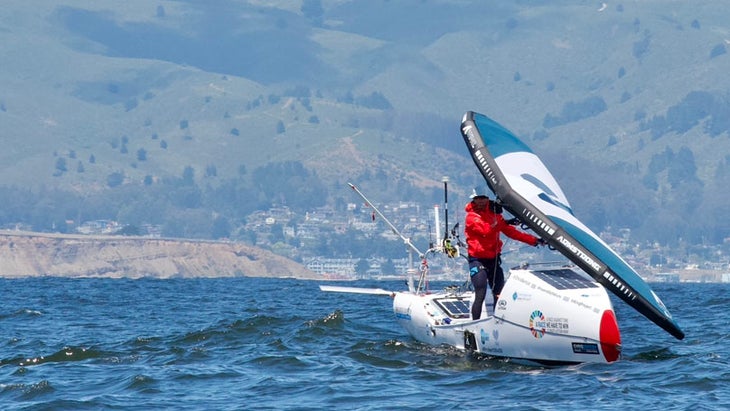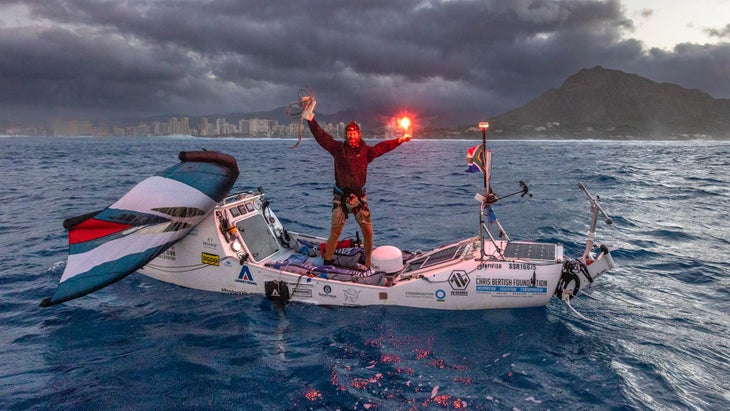Chris Bertish Fought Through Raucous Waves and a Head Injury on His Historic Trans-Pacific Trek
In mid-July, a massive southerly swell pounded Hawaii with once-in-a-decade waves that prompted some surfers to label it the best of all time. Aboard his custom-built survival craft, surfer and ocean adventurer Chris Bertish got an up-close view of the heaving ocean.
Bertish was in the final stretch of his Trans-Pacific Wing Project, a historic 2,465-mile solo crossing from California to Hawaii in a small survival craft powered by a handheld wing. He was rounding the island of Molokai, in the final stretch of his voyage, when he encountered the most radical ocean conditions of his life.
“I was taking off down waves on a craft that wasn’t meant to surf, and I was going like 16-18 knots,” Bertish said. “At one point the craft broached (an abrupt change in course) when I was inside the cabin, causing me to hit my head, concuss myself and start bleeding.”
Inside his 20-foot craft, called the ImpiFish, Bertish pushed on across the Molokai channel to Oahu in waves that were even bigger than those he experienced that day. The terrifying journey was an appropriate final leg of what had been a punishing test of skill and nerve. He had crossed 2,400 miles of open ocean from California to Hawaii in just over 48 days.
 Bertish began his journey in Santa Cruz, California. (Photo: Quin O’Hara)
Bertish began his journey in Santa Cruz, California. (Photo: Quin O’Hara)Bertish already has a long history of weathering high seas. The 48-year old South African vaulted onto the international surfing stage in 2010 when he won California’s famed Maverick’s International big-wave tournament. Bertish surfed 50-foot waves on a borrowed board to win the event.
Then, seven years later, Bertish again generated international acclaim for recording the first-ever crossing of the Atlantic aboard a stand-up paddleboard. His 4,050-mile journey from Morocco to the island of Antigua took 93 days to complete, and he did it aboard the ImpiFish, a custom-built SUP designed by naval architect Phil Morrison and inspired by elements of open-ocean rowboats. At four feet wide, 20 feet long, and 1,350 pounds unloaded, it took four months to build and cost nearly $100,000.
Bertish says that expedition was a valuable stepping stone for his biggest project yet, the Trans-Pacific wing voyage.
“People forget when something’s never been done before, you’re pioneering and having to create new systems,” said Bertish. “I was able to apply all the knowledge and insights I learned from the transatlantic crossing to upscale, upgrade, and remedy my ImpiFish, enabling me to deal with the new challenges I faced in the Pacific.”
The Pacific crossing from California to Hawaii is notoriously one of the most difficult in the world—particularly for small vessels like the ImpiFish. To date, sea kayaker Ed Gillett is the only person to successfully paddle across in a kayak, a 1987 crossing that took 63 death-defying days—recounted in harrowing detail in Dave Shively’s gripping book, The Pacific Alone: The Untold Story of Kayaking’s Boldest Voyage. Others have tried, sometimes suffering tragic fates. In 2020, Paralympic rower Angela Madsen died while attempting to cross the Pacific on her rowboat Row of Life, a project that was supposed to inspire others and produce a documentary film.
Currently, Frenchman Cyril Derreumaux is amid his quest to become the second solo kayaker to make the crossing. In late July, four women broke the women’s world record for the fastest four-rower team in the Great Pacific Race—an annual 2400-mile rowing race from California to Hawaii.
A wing-foil is an entirely different craft with an entirely different set of challenges. Bertish first attempted the crossing last year, but an electrical malfunction forced him back to shore after completing only 212 miles. To put into perspective just how new wing foiling is, Bertish’s failed attempt last year was still enough to claim a world record for longest distance traveled on a wing-foil, solo and unsupported.
In preparation for his wing-powered voyage, Bertish had to upgrade the ImpiFish craft. He added a series of metal foils to the side and bottom of the craft to increase its speed and stability in the water. He also added various apparatus and harnesses to help secure him to both the vessel and his handheld wing, which he used to power through the surf.
“I had eight wings that were built specifically for this journey by Armstrong,” said Bertish. “They were Carbon Mylar-reinforced and ranged in size from 5.5 meters down to 1.25 meters. There’s not even a training wing that exists on the planet that’s 1.25, but I used it all the time.”
But those upgrades couldn’t prepare Bertish for some of the challenges he faced on the high seas. He departed Santa Cruz, California on May 31st and immediately found himself amid cold, foggy, and overcast conditions. The miserable weather lasted for the first three weeks of the journey, slowing his progress as Bertish inched towards better conditions created by the trade winds.
Bertish spent roughly 12 hours a day “winging”—an enormously challenging task requiring him to balance on the deck of the ImpiFish while contracting and tweaking a handheld wing to catch wind and propel his craft forward. When Bertish wasn’t winging, repairing his craft, or catching a couple hours of rest, he managed to send out several social media updates with Captain’s Vlogs.
Bertish also endured a series of technical calamities that nearly ended his journey. During his time at sea, he battled countless systems failures, nearly lost all communications, and narrowly avoided serious injury during multiple falls—including one that took out his VHF radio antennae only three days into the trip.
At one point, his hydro-charger—an underwater generator that uses a propeller to produce energy and recharge the craft’s battery banks—began to separate the base plate off the transom and cause a leak into the stern of his craft, where all his main electronic systems were located.
“If I hadn’t checked and just went another night with that issue in place, it would’ve flooded my back compartment without me even knowing,” said Bertish. “Then that would have shorted all of my systems and I probably would have sunk.”
Bertish found the issue during his daily maintenance check and after a quick repair job—using an emergency underwater epoxy repair kit—he averted disaster.
Not everything went wrong. His food situation was “like cordon bleu compared to the transatlantic.” He lived for two months on a backpacker’s diet consisting of nuts, dried fruit, supplements, and freeze-dried meals that had to be prepared inside his tiny cabin.
“When you’re in a cabin as wide as your shoulders and the craft is getting bashed around by waves, it’s challenging to hold a Jet Boil with a live flame and pour boiling water into a pouch,” he said. “Fortunately, I’ve been doing this for quite a long time.”
Nothing comes easy on the high seas but reaching the trade winds put the wind at his back. Bertish tied off his wing like an “inverted Spinnaker” and managed to enjoy a few days of hands-free winging. It would prove to be the calm before the storm, the punishing southerly swell served up a daunting final test once he reached the Hawaiian Islands. Bertish leaned on his most valuable asset to navigate this perilous final leg—a lifetime of experience in heavy ocean conditions.
 Bertish survived rough seas and bad weather to arrive in Hawaii. (Photo: Quin O’Hara)
Bertish survived rough seas and bad weather to arrive in Hawaii. (Photo: Quin O’Hara)Once he finally docked at the Hawaii Yacht Club in Honolulu on July 17th—after spending 48 days, 15 hours, and 15 minutes at sea—he didn’t stay on land for long.
“About three hours after I landed, I managed to go out and get a couple waves with Jamie Mitchell at one of the outside reefs. That was pretty epic.”
Following the massive accomplishment, Bertish’s work is only just beginning. The Trans-Pacific Wing Project was dedicated to raising both money and awareness for ocean conservation, with proceeds from the journey going to Conservation International, Sea Shepard, Parley, and SeaTrees Initiative.
“I had several very scary situations that I encountered on my journey, but the most terrifying thing I saw was the amount of plastic pollution.”
Bertish said he only saw five fish, compared to 67 pieces of floating plastic debris. The contrast was shocking, and it inspired him to release an emotional Instagram post in hopes of raising awareness of an ocean pollution problem growing by the day.
“When all you’re seeing is ocean pollution, in a place where people would expect the ocean to be in its most pure and abundant state, that’s terrifying.”
He’ll be taking that message on the road to support his new book coming out—All In—which recounts his transatlantic expedition experience. The book is slated to hit bookshelves in January here in the States, with South Africa seeing a November release. At the end of his tour, Bertish plans on auctioning off the ImpiFish at the Miami Boat Show next April.
The ImpiFish may be headed towards a much-deserved retirement, but Bertish is already well underway with planning his biggest expedition yet: Ocean 17 Project, a sailing expedition around the world that will raise awareness for ocean education, conservation, and sustainability. The project is inspired by the United Nation’s 17 Sustainable Development Goals.
“It will start at the end of 2025,” said Bertish. “It will go around the world and will probably be five to eight times bigger than all of the other projects I’ve done, put together.”
While many of the details are under wraps, one thing is certain—Bertish will push the boundaries of human endurance and willpower, yet again.
By accepting you will be accessing a service provided by a third-party external to https://oc3anclub.com/

